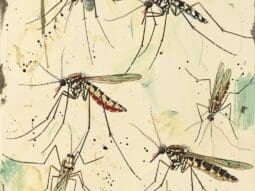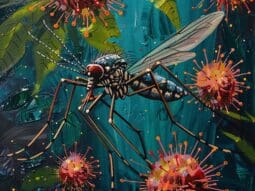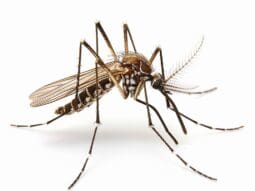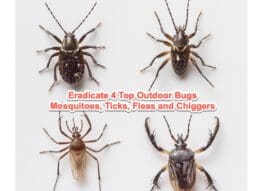
Identify & Combat Asian Cockroaches
Table of Contents
- Characteristics of Asian Cockroaches
- Differences Between Asian Cockroaches and German Cockroaches
- Habits and Behaviors of Asian Cockroaches
- How to Identify Asian Cockroaches
- Tips for Effective Treatment and Prevention
- Conclusion
Ever stumbled upon a cockroach that took to the skies right when you were about to swat it? Chances are, you've had a close encounter with the Asian cockroach, a species that's been buzzing around the US since its discovery in Florida in 1986. Unlike its flightless cousins, these pests are known for their impressive aerial abilities.
Identifying these critters is crucial, as mistaking them for their look-alike, the German cockroach, can lead to ineffective treatment strategies. I'll guide you through their unique characteristics and behaviors, ensuring you're well-equipped to tackle these winged invaders. Let's dive into the world of Asian cockroaches and learn how to distinguish these light-loving fliers from their terrestrial counterparts.
Characteristics of Asian Cockroaches
Identifying Asian cockroaches begins by noting their size and color. At about half an inch long, these pests can be mistakenly identified as German cockroaches, which can derail your pest control efforts. However, if you know what to look for, you can distinguish them easily. Asian cockroaches are a lighter brown and possess slightly longer and narrower wings compared to their German counterparts.
One of the most notable behaviors of Asian cockroaches is their capability to fly. This characteristic sets them apart from most other roach species. When disturbed, I've observed them flying up to 120 feet, a surprising distance that underscores their mobility. My experience aligns with the data; such agility requires tailored management strategies, as traditional roach treatments may prove less effective.
I've also noticed these pests are peculiarly attracted to well-lit areas. Their attraction to light makes them unique among cockroaches, which typically shy away from brightness. This detail is critical when devising a control plan, as it influences both where Asian cockroaches are likely to be found and how to attract them into traps.
Despite their prevalence since their arrival in Florida in 1986, controlling Asian cockroaches necessitates a bespoke approach. They carry germs and diseases, posing a risk to human health, and therefore cannot be managed simply as one would any common cockroach. Recognizing these distinctive characteristics is crucial in keeping Asian cockroaches at bay, protecting your home or property from the health hazards they bring.
Differences Between Asian Cockroaches and German Cockroaches
Identifying the key differences between Asian and German cockroaches is crucial for effective pest management. Asian cockroaches, with a Latin name Blattella asahinai Mizukubo, are typically less than an inch in size and exhibit a tan to dark brown color. While they bear a striking resemblance to German cockroaches, the defining features are their pronotal stripes, which are darker and more pronounced.
The behavioral patterns of these species significantly diverge:
- Flying ability: Asian cockroaches are equipped with long, narrow wings that afford them an impressive flying capability. They can cover distances up to 120 feet, which starkly contrasts the non-flying German cockroach.
- Attraction to light: Unlike the German variety, which shuns the light, Asian cockroaches are notably drawn to bright areas. This means they are often spotted fluttering towards illuminated spaces, such as entryways and porch lights.
Since their introduction in Kathleen, Fla, in 1986, Asian cockroaches have often been confused with the German cockroach. Experienced specialists struggle to differentiate between the two species based on appearance alone. However, when examining the egg cases, researchers discovered that although the Asian cockroach's ootheca is smaller, this is simply due to the smaller size of the egg compartments rather than a lesser quantity. The nymphs of the Asian cockroach also trend smaller when compared to those of German cockroaches.
Understanding these differences is not just an academic exercise. It’s about ensuring that management strategies target the right cockroach species. Since Asian cockroaches are prolific fliers and are attracted to light, control methods that work for the largely indoor-dwelling German cockroaches will likely be ineffective for their airborne cousins. This requires pest control strategies to be flexible and context-sensitive, taking into account the unique behaviors and tendencies of each species.
Habits and Behaviors of Asian Cockroaches
Asian cockroaches exhibit distinct habits and behaviors that set them apart from other species, especially the German cockroach. These nuances are crucial for homeowners to understand for proper pest management.
Unlike the German cockroach, Asian cockroaches have a remarkable ability to fly. I've observed that their long, narrow wings equip them to soar distances of up to 120 feet, making them agile pests that can quickly invade new territories, including human residences. Their flight capabilities allow them to easily access high locations, such as atop kitchen cabinets or even on the upper floors of buildings.
At the onset of evening, their activity spikes. It's intriguing how they're drawn to light, which can lead to them amassing around brightly lit entryways or porch lights. The way they are attracted to light sources can lead to possible intrusion into homes, as they aim for the light reflected off walls or doorways. It's not uncommon to find them resting on illuminated surfaces like lamp shades or electronic screens.
Here's a snapshot of what to look for:
- Appearance: Size under 1 inch, tan to dark brown, defined pronotal stripes.
- Activity: Highest at dusk, drawn to brightly lit areas.
- Habitat: Predominantly outdoor, both feral and peridomestic environments.
Feeding habits are another area where Asian cockroaches prove to be versatile. These omnivores don't discriminate when it comes to food sources, consuming plant matter, flowers, and surprisingly even household items like toothpaste. This broad diet supports their ability to flourish in various environments, making them a problematic pest when not controlled.
These cockroaches' proclivity for flight and their omnivorous diet are vital factors contributing to their rapid reproduction and colonization of new areas. Their presence in high places and temptation to follow light from room to room can sometimes give the eerie impression that they're pursuing humans, when in truth, they're merely chasing the glow.
How to Identify Asian Cockroaches
I've encountered numerous types of cockroaches over the years, but Asian cockroaches (Blattella asahinai Mizukubo) undoubtedly stand out. Learning how to tell them apart from other species like the German cockroach is crucial, primarily for effective control measures. When exploring your surroundings for these pests, there are a few identifying characteristics to keep in mind.
Firstly, Asian cockroaches are somewhat small, usually under one inch in length. Their color ranges from a tan to dark brown shade, similar to German cockroaches. However, the definitive feature that sets them apart is the pronotum—a plate-like structure on their thorax. Asian cockroaches exhibit darker, more defined stripes on this part, which can serve as a clear indicator when trying to distinguish them.
Moreover, their wings explain a lot about their behavior. Unlike their German counterparts, Asian cockroaches boast long, narrow wings, which empower them to sustain flight for distances of at least 120 feet. This ability to fly not only helps in identifying them but also in understanding their movement patterns around your home.
It's essential to consider their behavior when identifying these insects. Notably, Asian cockroaches are attracted to light. If you observe cockroaches flying towards bright areas such as entryways or porch lights at night, there's a good chance they're Asian cockroaches. This propensity for light vastly differs from the habits of German cockroaches, which typically avoid well-lit areas.
Remember, while their prevalence can spike during early spring and summer, their nocturnal nature means an infestation can develop unnoticed. If you come across cockroaches in or around your home exhibiting these characteristics, it's likely you’re dealing with the Asian variety. Identifying them accurately is the first step in managing their presence effectively.
Tips for Effective Treatment and Prevention
When dealing with Asian cockroaches, effective treatment hinges on accurate identification. If you're unsure about which species you're encountering, it's crucial to determine this first, as the control strategies can vary significantly. Once you've confirmed the presence of Asian cockroaches, let's dive into the necessary steps to manage them.
To prevent a cockroach infestation, I'm a firm believer in proactive measures. First and foremost, keeping your environment clean is non-negotiable. I make it a point to vacuum frequently, ensuring no crumbs or debris accumulate. A spotless kitchen is an uninviting one for cockroaches. Utilizing a dehumidifier can also ward off these pests by reducing moisture, which they find essential.
It's equally important to address the exterior of your home. A thorough examination to seal potential entry points is crucial. I recommend:
- Using silicone-based caulk to seal cracks around doors, windows, and utility lines.
- Installing screens on vents and sealing gaps around utility pipes.
- Ensuring proper ventilation in crawl spaces to prevent moisture buildup.
Remember, Oriental cockroaches, which are often mistaken for Asian cockroaches, require a different approach as they prefer to live outdoors. However, similar preventative methods, such as eliminating standing water and reducing mulch and plant debris, can benefit both species.
If these roaches have made their way indoors, understand that typical indoor pesticides might not hit the mark. Instead, focus on making your property less attractive to these pests:
- Cut back on mulch and plant debris around your home.
- Clear out standing water near your foundation.
For those having trouble with Asian cockroaches, specific outdoor pesticides have proven to be effective. However, please always make sure that you're using a product designed to target these pests. After having managed an infestation, ongoing diligence is key to prevention. Regular checks and maintenance around your home can go a long way in keeping these unwanted visitors at bay.
Conclusion
We've shared my insights on the elusive Asian cockroaches and their unique challenges. Remember that recognizing their distinct markings and flight capability is critical to distinguishing them from other species. With the strategies I've outlined—maintaining cleanliness, controlling humidity, sealing up your home, and using targeted pesticides—you're well-equipped to tackle any issues with these pests. Stay vigilant with regular inspections to keep your space cockroach-free. It's all about being proactive to ensure these unwelcome guests don't become permanent residents in your home. Romex Pest Control is an expert in identifying and treating Asian Cockroaches. Give us a call, we are happy to help you get rid of these annoying pests.
Still haven't found the information you are looking for? Provide your information below, and we will use our AI Pest Detective to provide your next steps and deliver more specifics to your inbox.
Your Journey to Pest-free
50+ Years Experience. Eco-Friendly, Pet-Friendly, and Kid-Friendly Treatments. Results Guaranteed. Romex Pest Control
Romex Pest Control is committed to protecting you, your children, and your pets with our eco-friendly, child-friendly, and pet-friendly guaranteed pest control solution.
We are confident in solving all pest, rodent, and termite problems.
Romex Pest Control is fully insured and licensed in Texas, Oklahoma, Louisiana, and Mississippi.
Established 2016 © Copyright 2024 Romex Pest Control










